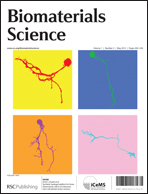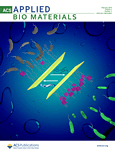
Biomaterials Advances
Scope & Guideline
Pioneering Research in Biomaterials and Biomedical Engineering
Introduction
Aims and Scopes
- Biomaterials for Tissue Engineering:
The journal emphasizes the development of novel biomaterials for tissue engineering applications, including scaffolds for bone, cartilage, and soft tissue regeneration. - Nanotechnology in Biomaterials:
Significant focus is placed on the incorporation of nanotechnology into biomaterials, enhancing their properties for targeted drug delivery, imaging, and therapeutic applications. - Biocompatibility and Biodegradability:
Research addressing the biocompatibility and biodegradability of materials is crucial, ensuring that biomaterials are safe for use in medical applications and can degrade appropriately in biological environments. - Smart and Responsive Materials:
The journal highlights the design of smart materials that respond to environmental stimuli (e.g., pH, temperature, light) for controlled drug release and therapeutic effects. - Sustainable and Green Synthesis:
There is a growing emphasis on sustainable practices in biomaterials research, including the use of bio-based materials and eco-friendly synthesis methods. - Regenerative Medicine:
Biomaterials Advances covers research that supports regenerative medicine strategies, including stem cell therapy and tissue engineering, to restore or replace damaged tissues. - Multifunctional Materials:
The journal is interested in multifunctional biomaterials that serve multiple roles, such as antibacterial, osteogenic, and drug delivery capabilities.
Trending and Emerging
- 3D Bioprinting and Biofabrication:
There is a significant increase in research focusing on 3D bioprinting technologies for creating complex tissue structures, emphasizing the importance of fabrication techniques in tissue engineering. - Regenerative and Personalized Medicine:
Emerging themes include the application of biomaterials in regenerative medicine, with a focus on personalized approaches that cater to individual patient needs through tailored biomaterial solutions. - Bioactive and Smart Hydrogels:
Research on bioactive and smart hydrogels is trending, particularly those that can respond dynamically to environmental changes and promote healing in various tissue types. - Nanomaterials for Cancer Therapy:
The integration of nanomaterials in cancer therapy, particularly for targeted drug delivery and photothermal therapy, is gaining momentum, reflecting an increasing interest in precision medicine. - Sustainable Biomaterials:
A growing trend towards the use of sustainable and eco-friendly materials in biomedical applications is evident, highlighting the need for environmentally responsible practices in biomaterials research. - Advanced Coatings and Surface Modifications:
Research into advanced coatings and surface modifications for implants and devices is becoming more prevalent, focusing on enhancing biocompatibility, antimicrobial properties, and functionality.
Declining or Waning
- Traditional Synthetic Polymers:
Research on traditional synthetic polymers without functional modifications is declining as newer, more advanced materials with enhanced properties gain prominence. - Basic Biomechanical Studies:
There is a noticeable shift away from purely biomechanical studies towards more integrated approaches that combine material science with biological interactions, indicating a waning interest in isolated biomechanical assessments. - Conventional Drug Delivery Systems:
Publications focusing on conventional drug delivery systems are declining in favor of more innovative, targeted, and responsive delivery mechanisms that utilize nanotechnology and biomimetic approaches. - Single-Function Biomaterials:
There is a reduced emphasis on the development of single-function biomaterials as researchers increasingly pursue multifunctional materials that can address multiple therapeutic needs. - In vitro Studies Without Clinical Relevance:
There is a decreasing trend in research that does not connect in vitro findings to potential in vivo applications or clinical relevance, as the field moves towards more translational research.
Similar Journals

Journal of Materials Chemistry B
Advancing the Frontiers of Materials Chemistry.Journal of Materials Chemistry B is a prestigious peer-reviewed journal published by the Royal Society of Chemistry, specializing in the latest advancements in the realm of materials chemistry. With a profound impact in the scientific community, this journal has achieved impressive Q1 quartile rankings in 2023 across several categories, including Biomedical Engineering, Miscellaneous Chemistry, Materials Science, and Medicine, illustrating its pivotal role in interdisciplinary research. Its impressive Scopus rankings further emphasize its widespread recognition, with notable placements in the top percentiles for various fields. Covering a broad scope of topics from novel materials for biomedical applications to innovative chemical synthesis techniques, the journal aims to promote knowledge exchange and foster collaborative research across disciplines. Although not an open-access journal, it offers a platform for researchers to share their findings and contribute to the evolving discourse within materials science. With a publication record spanning from 2013 to 2024, the Journal of Materials Chemistry B remains an essential resource for researchers, professionals, and students dedicated to exploring the frontiers of materials chemistry.

Materials
Exploring the frontiers of materials research with open access insights.Materials is an esteemed journal published by MDPI, dedicated to advancing the fields of Condensed Matter Physics and Materials Science. With its commitment to Open Access since its inception in 2008, the journal has made significant strides in disseminating high-quality research globally, allowing researchers, professionals, and students easy access to cutting-edge studies without financial barriers. Hailing from Switzerland, the journal has shown remarkable growth and prominence, currently ranked in the Q2 quartile in its categories according to the latest assessments, which highlights its impact within the community. As the journal converges its focus from 2008 to 2024, it aims to continually foster a robust exchange of knowledge on innovative materials and their applications, thereby supporting the evolving landscape of science and technology. With an E-ISSN of 1996-1944 and a user-friendly platform, Materials is poised to be a leading choice for scholars eager to contribute to and engage with pioneering research.

Frontiers in Bioengineering and Biotechnology
Exploring New Horizons in Bioengineering and BiotechnologyFrontiers in Bioengineering and Biotechnology, published by FRONTIERS MEDIA SA in Switzerland, stands as a leading platform for innovative research and developments in the fields of bioengineering and biotechnology. Since its inception in 2013, this Open Access journal has garnered significant recognition, reflected in its impressive category rankings: Q1 in Biomedical Engineering and Q2 in Bioengineering, Biotechnology, and Histology for 2023. With a focus on fostering collaboration and knowledge sharing, it aims to provide researchers, professionals, and students with access to pioneering studies that push the boundaries of science and technology. The journal, which is indexed in prominent databases, boasts high visibility and impact, evidenced by its impressive rankings across various categories in Scopus. As it continues to converge from 2013 to 2024, Frontiers in Bioengineering and Biotechnology is dedicated to shaping the discourse in its field and promoting advancements that have the potential to transform healthcare and environmental sustainability.

Journal of Functional Biomaterials
Unleashing Potential in Biomaterials ResearchJournal of Functional Biomaterials is a prominent peer-reviewed journal dedicated to the innovation and application of biomaterials, covering vital fields such as biomedical engineering and materials science. Published by MDPI in Switzerland, this Open Access journal has been serving the academic community since 2010, allowing unrestricted access to groundbreaking research. With an impressive Q2 ranking in both Biomaterials and Biomedical Engineering for 2023, it stands as a significant contributor to the fields it represents. Researchers will find the journal's focus on functional biomaterials particularly relevant, as it encompasses a diverse range of studies aimed at enhancing the performance and applicability of biomaterials in medical contexts. The journal's commitment to disseminating high-quality research fosters collaboration and innovation among professionals, making it an essential resource for anyone involved in this dynamic area of study.

Biomedical Materials
Innovative Insights for Enhanced Patient Care.Biomedical Materials, published by IOP Publishing Ltd, is a premier journal dedicated to the rapidly evolving field of biomedical engineering and materials science. With a robust impact factor showcasing its influence, this journal serves as a vital platform for disseminating pioneering research from 2006 to 2024. Covering an array of interdisciplinary topics—ranging from biomaterials to bioengineering and applied chemistry—the journal consistently ranks in the second quartile across multiple categories including Bioengineering (Q2), Biomaterials (Q2), and Biomedical Engineering (Q2) as of 2023. Researchers, professionals, and students alike benefit from its contributions, exploring innovative solutions at the intersection of biology and material science. Although not an Open Access journal, Biomedical Materials remains essential in advancing our understanding and facilitating discussions surrounding state-of-the-art materials that revolutionize medical applications and enhance patient care.

JOURNAL OF BIOMATERIALS SCIENCE-POLYMER EDITION
Pioneering research in polymer-based solutions for biomedicine.JOURNAL OF BIOMATERIALS SCIENCE-POLYMER EDITION, published by Taylor & Francis Ltd, is a distinguished scholarly journal dedicated to the exploration of biomaterials and their applications in various fields such as bioengineering, biomedical engineering, and biophysics. With an ISSN of 0920-5063 and an E-ISSN of 1568-5624, this journal offers a platform for researchers and professionals to share innovative findings and methodologies that advance the science of polymer-based biomaterials. The journal's impact within the academic community is underscored by its notable Scopus rankings, including a Q2 status in both Biomedical Engineering and Biophysics as of 2023, reflecting its significant contribution to advancing knowledge and practice in these fields. The scope of the journal spans from fundamental research to applications in medical devices and regenerative medicine, ensuring comprehensive coverage of the latest trends and breakthroughs. Although it does not currently offer open access options, the journal remains a pivotal resource for students, researchers, and professionals committed to the development and application of biomaterials in healthcare. For further details, the journal is based in Abingdon, United Kingdom, at 2-4 Park Square, Milton Park, OX14 4RN.

Biomaterials Science
Exploring the intersection of materials science and biomedical engineering.Biomaterials Science is a premier journal published by the Royal Society of Chemistry that serves as a leading platform for researchers and professionals in the fields of Biomedical Engineering and Materials Science. With an impressive impact factor bolstered by its Q1 quartile ranking in both disciplines, this journal has positioned itself at the forefront of cutting-edge research, showcasing innovative materials and applications that drive advancements in healthcare and technology. Since its inception in 2013, Biomaterials Science has been committed to disseminating high-quality, peer-reviewed articles that promote scientific knowledge and collaboration among academia and industry. With a global readership and a focus on open access, researchers are encouraged to share their findings to facilitate the development of transformative biomaterials and their applications. Join a vibrant community of scholars as we explore the future of biomaterials through this esteemed publication, enhancing both scientific inquiry and practical application.

ACS Applied Bio Materials
Innovating the Future of Bioengineering and Materials ScienceACS Applied Bio Materials is a leading academic journal published by the American Chemical Society, focusing on the innovative intersection of bioengineering and materials science. Since its inception in 2018, the journal has established itself as a pivotal platform for disseminating impactful research within the fields of Biochemistry, Biomaterials, Biomedical Engineering, and Chemistry, often ranked in the top tiers of these categories. With an impressive impact factor, it holds a Q2 ranking in both Biochemistry and Biomaterials, and a prestigious Q1 ranking in Biomedical Engineering and miscellaneous Chemistry, underscoring its significance in advancing knowledge and practices across these disciplines. The journal’s editorial commitment to high-quality, peer-reviewed research ensures relevance and rigor, appealing to a diverse audience of researchers, professionals, and students keen to explore breakthroughs in bio-related materials technology. The access options enhance its visibility and reach, allowing for a broader dissemination of studies that drive innovation and collaboration in biotechnology and material sciences. Located in the heart of Washington, DC, ACS Applied Bio Materials serves as a crucial resource for advancing the future of healthcare, engineering, and materials research.

Acta Biomaterialia
Shaping the Landscape of Biomedical InnovationActa Biomaterialia, published by Elsevier Science Ltd, is a leading journal in the fields of biochemistry, biomaterials, biomedical engineering, biotechnology, and molecular biology. With an ISSN of 1742-7061 and an E-ISSN of 1878-7568, this prestigious journal has secured a remarkable position in the academic community, evidenced by its inclusion in the Q1 category across multiple disciplines for 2023. It ranks impressively at #21 in biochemistry, #16 in biomedical engineering, #18 in biotechnology, and #11 in biomaterials, reflecting its high impact and relevance to ongoing research and development. The journal provides a platform for disseminating innovative research and advancements in the design and application of biomaterials, contributing to scientific discussions that propel the field forward. Although it does not currently offer open access options, Acta Biomaterialia continues to attract contributions that advance our understanding of biomaterials and their interactions with biological systems, ensuring that researchers, professionals, and students remain informed about the latest trends and breakthroughs in this rapidly evolving area of study.

JOURNAL OF MATERIALS SCIENCE-MATERIALS IN MEDICINE
Unleashing the Potential of Materials in Medical ApplicationsJOURNAL OF MATERIALS SCIENCE-MATERIALS IN MEDICINE is a leading peer-reviewed journal published by Springer, dedicated to advancing the field of biomedical materials science. With an ISSN of 0957-4530 and E-ISSN 1573-4838, this Open Access journal has been committed to providing researchers and professionals with freely accessible, high-quality research since 2021. It features an extensive scope spanning bioengineering, biomaterials, biomedical engineering, and biophysics, reflecting its significant impact within these interdisciplinary domains. Recognized within the Q2 category of the 2023 rankings in multiple fields, the journal proudly positions itself as a crucial resource for innovative materials that contribute to advancements in medical applications. With impressive Scopus rankings, including 26th in Biophysics and 40th in Materials Science for Biomaterials, researchers, students, and industry professionals alike can rely on this publication for cutting-edge insights that drive the future of medical materials and technologies. Based in Dordrecht, Netherlands, the journal provides a vibrant platform for sharing groundbreaking discoveries and fostering collaborative research among a global audience.